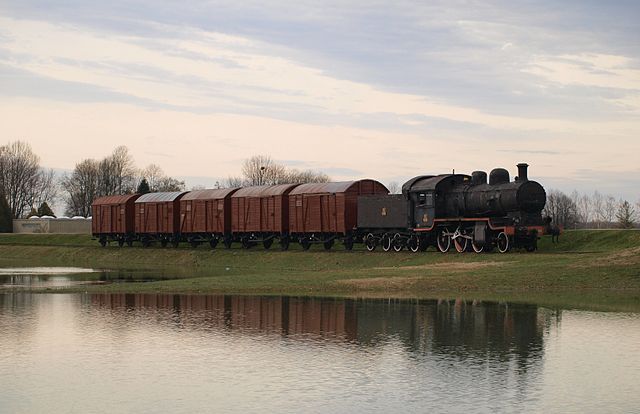Jasenovac concentration camp

„Death train“ used to transport inmates to Jasenovac (Photo: Petar Milošević)
In August 1941, near the village of Jasenovac, at the confluence of the Sava and Una rivers, the Ustaša regime established a Jasenovac concentration camp. Unlike most camps in occupied Europe, it was not run by Nazi Germany, but directly by the Independent State of Croatia. Over time Jasenovac became one of the largest camps in Europe, often referred to as ” the Auschwitz of the Balkans”. Vjekoslav “Maks” Luburić, head of the Ustasha Surveillance Service (UNS), was responsible for overseeing all the Ustaša camps.
Known for its extremely brutal conditions and large number of victims, the camp was a complex of five sub-camps covering an area of 210 km2, the largest of which was “Brickyard” in Jasenovac. The complex also included the camp in Stara Gradiška, the killing field at Donja Gradina, five working camps on surrounding farms, and a Roma camp in the village of Uštica. The camp was established with the full support of Nazi Germany, who encouraged the regime to resolve the issue of Jews and Roma, while supporting plans to eliminate Serbs. The Germans often assisted the Ustaša in deporting and transporting prisoners to camps. In addition to Serbs, Jews, and Roma, numerous Croats and Bosniaks whose political activities defied the regime also ended up in Jasenovac. Both men, women, and children were taken to Jasenovac, without exception.
Upon their arrival, the inmates were marked with colors (but not Roma). Most of them were soon killed at the execution sites near the camp, while individuals with useful occupations and trades (doctors, pharmacists, shoemakers, goldsmiths, etc.) were left alive and forced to work. Jasenovac was known for particularly severe and inhuman conditions: starvation, lack of drinking water (inmates drank water from the Sava River), overcrowded and damp barracks, or sleeping in open, exhausting forced labor (working 11 hours a day), a general lack of hygiene, frequent outbreaks of infectious diseases such as typhoid, malaria, flu, diphtheria, and dysentery, and daily beatings, mistreatment, and torture.
The fact that Jasenovac was an “extermination camp” like Auschwitz or Treblinka is supported by the fact that most of the arriving prisoners were destined for execution. Only strong men and those with sentences below three years were sent to forced labor, others were killed in various ways: with poison gas in the chambers in Stara Gradiška, by cremation (while still alive), drowning in the Sava River, shooting, or by knives, saws, hammers, and males.
Today a heated discussion prevails regarding the number of Jasenovac victims. Jasenovac Memorial Site maintains a list of victims with over 80,000 names, estimating the overall number to be 100,000 victims. In 1943, Nazi intelligence service estimated that 120,000 people were killed in Jasenovac, with an additional 80,000 in Stara Gradiška. Some historians cite far higher figures, several hundred thousand victims each. Regardless of the final number, which will probably never be determined, the fact remains that Jasenovac was one of Europe’s deadliest camps.
